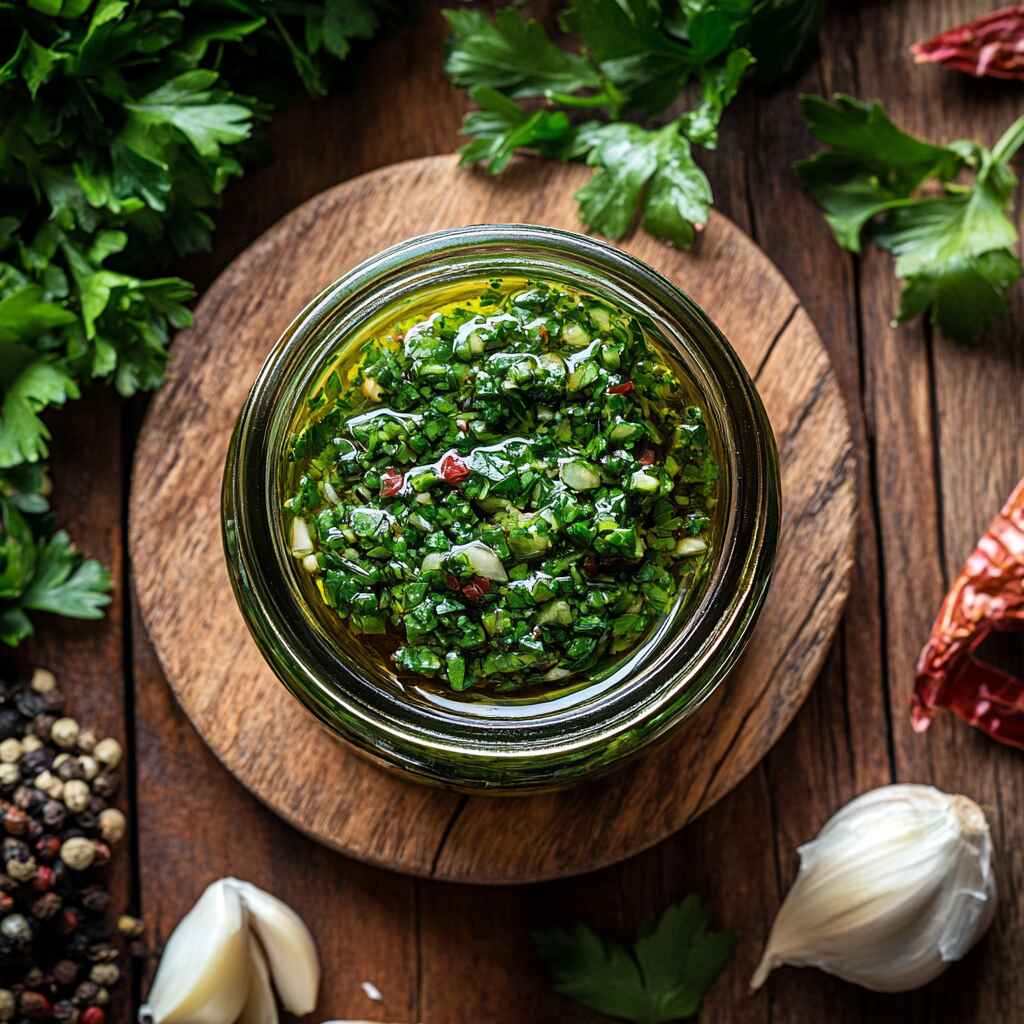Chimichurri sauce might just be the boldest thing your taste buds didn’t know they were missing. This vibrant green condiment from Argentina is more than a steak companion it’s a kitchen hero that turns simple ingredients into a flavorful moment. In this article, I’ll walk you through my personal connection to chimichurri, how to make it in minutes, ways to use it creatively, and smart tips to store it. Whether you’re a meat lover, veggie enthusiast, or sauce fanatic, this guide will show you why chimichurri sauce belongs in your everyday rotation.
Why Chimichurri Sauce Deserves a Place in Your Kitchen
From My Family Table to Argentina’s Streets
I first tasted chimichurri on a street in Buenos Aires, but it reminded me of home. My mother’s herb garden was always overflowing, and when I was little, I used to crush fresh parsley with olive oil, not knowing I was halfway to a chimichurri. Years later, standing near an Argentine grill with the aroma of garlic and vinegar dancing in the air, it hit me this sauce feels like home, even if you’ve never been there. And once I made it myself, it never left my table. Chimichurri sauce, like the meals my grandfather believed could heal anything, connects stories, cultures, and cravings in one bright spoonful.
What Is Chimichurri Sauce?
Chimichurri sauce is a bold, herby condiment from Argentina and Uruguay. It’s typically made with parsley, garlic, olive oil, oregano, and red wine vinegar, delivering a balance of freshness, tanginess, and heat. Think of it as South America’s answer to pesto but with no cheese, no nuts, and more vinegar-forward punch. You’ll find it drizzled over grilled meats, tossed into vegetables, or spooned onto rice and potatoes. Its versatility is what makes it a staple, and its flavor is why it’s unforgettable.
In my version, I also add a pinch of smoked paprika it’s not traditional, but it adds a layer of warmth that complements both roasted vegetables and steak beautifully. Whether you spoon it over grilled zucchini or steak fajitas, chimichurri sauce transforms ordinary dishes into feasts.
How to Make Chimichurri Sauce
Simple Ingredients, Big Flavor
Classic Chimichurri Sauce Ingredients
Making authentic chimichurri sauce at home couldn’t be easier and the beauty lies in its simplicity. All you need are a handful of pantry and fresh ingredients:
- Fresh flat-leaf parsley : The foundation of the sauce. Chop it finely for the best texture.
- Garlic : Just one clove adds the punchy depth chimichurri is known for.
- Red wine vinegar : Its acidity balances the richness of the oil and brings that signature zing.
- Extra virgin olive oil : Use a good quality oil to carry the flavors.
- Dried oregano : Adds a mild earthiness.
- Red pepper flakes : Just a bit for a whisper of heat.
- Smoked paprika (optional) : Not traditional, but I love its warm, smoky undertone.
- Sea salt : A must to bring everything together.
Tips to Make It Perfect Every Time
The magic of chimichurri is in its freshness, so use ingredients that are bright and bold. Chop the parsley finely by hand it creates a better texture than using a blender, which can turn it into a paste. Garlic should be minced, not crushed, and vinegar should always go in before the oil to help blend the flavor layers.
You can make the sauce ahead of time and let it rest for 20–30 minutes before serving it gives the flavors time to marry. For storage, keep it in an airtight jar in the fridge for up to 4 days. You can also freeze leftovers in ice cube trays for quick use just pop out a cube and stir it into roasted potatoes or grilled chicken when needed.
Best Ways to Use Chimichurri Sauce
Beyond the Grill – Versatile Chimichurri Ideas
Chimichurri on Steak, Chicken, and More
While chimichurri sauce is famous for topping grilled steak in Argentina, its magic doesn’t stop there. Drizzle it over seared flank steak, spoon it onto grilled chicken thighs, or brush it onto shrimp skewers before grilling. The oil and vinegar base helps it cling to proteins, while the fresh parsley and garlic cut through the richness of meat, creating an irresistible balance.
Use it as a marinade before grilling or a finishing sauce afterward it’s great both ways. Just avoid heating it directly, as the fresh herbs are best served raw to preserve their vibrant flavor.
Creative & Vegetarian Uses for Chimichurri
Chimichurri isn’t just for meat lovers. One of my favorite ways to use it is on a plate of roasted vegetables especially crispy potatoes or charred broccoli. It brightens up hearty root veggies and complements the caramelized edges beautifully.
Try it spooned over a quinoa and roasted veggie bowl or as a dressing on your favorite green salad. I even swirl it into creamy polenta for an unexpected pop of flavor. Got a baked sweet potato on hand? A spoonful of chimichurri makes it downright addictive.
It’s also fantastic stirred into cooked grains like farro or brown rice, or used as a dipping sauce for warm, crusty bread.
Storing & Customizing Chimichurri Sauce
Fresh Today, Flavorful Later
How Long Does Chimichurri Last?
Chimichurri sauce keeps well for 4 to 5 days in the refrigerator when stored in an airtight container. Over time, the flavors deepen but the herbs will begin to lose their brightness, so use it while it’s fresh if possible.
Need to make it last longer? Pour it into an ice cube tray, freeze, then transfer cubes into a freezer-safe bag. You’ll have perfect portions ready to pop into warm grains or drizzle over roasted vegetables anytime. This works beautifully if you’re meal-prepping or cooking for one.
Just don’t reheat it over direct heat thaw it at room temp or stir into hot dishes to preserve its flavor.
Variations to Try
Chimichurri is incredibly customizable. While parsley is the traditional herb, you can use half parsley and half cilantro for a fresher twist—or go all-in on cilantro if you love it.
Swap the red wine vinegar with white wine vinegar or lemon juice for a brighter finish. Prefer more kick? Add a diced fresh chili or more red pepper flakes. Want it smoother? Pulse it briefly in a food processor but don’t overdo it or you’ll lose the texture.
You can even make a creamy version by adding a spoonful of Greek yogurt or avocado. Chimichurri sauce invites creativity, and once you’ve mastered the base, the variations are endless.
FAQs About Chimichurri Sauce
What is chimichurri sauce made of?
Chimichurri sauce is made with finely chopped parsley, garlic, red wine vinegar, olive oil, oregano, red pepper flakes, and sea salt. Some versions also include cilantro, paprika, or lemon juice for extra flavor.
Is chimichurri sauce spicy?
Traditional chimichurri isn’t very spicy, but it does have a subtle kick from red pepper flakes. You can make it spicier by adding more flakes or a chopped chili.
How long does chimichurri last?
It lasts up to 5 days in the fridge or up to 3 months in the freezer. Always store it in an airtight container and avoid direct heat when reheating.
What do you eat with chimichurri sauce?
Chimichurri pairs well with grilled steak, chicken, fish, roasted vegetables, potatoes, rice bowls, and even as a zesty salad dressing or dip for bread.
Why Chimichurri Sauce Belongs in Your Fridge
Chimichurri sauce is more than a condiment it’s a spark of bold flavor, a kitchen essential that brings life to any meal. Whether spooned over sizzling steak or stirred into a warm grain bowl, it’s a reminder that simple ingredients can create something extraordinary. In my kitchen, chimichurri isn’t just a recipe it’s a connection to places I’ve visited, people I’ve loved, and meals that felt like home.
So, grab that parsley, pour the oil, and start chopping. Your next favorite sauce is just minutes away and it might just become the flavor you never knew you needed.

